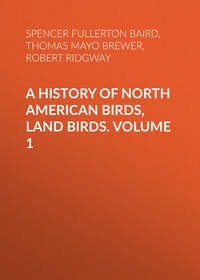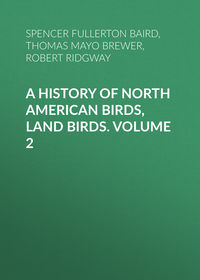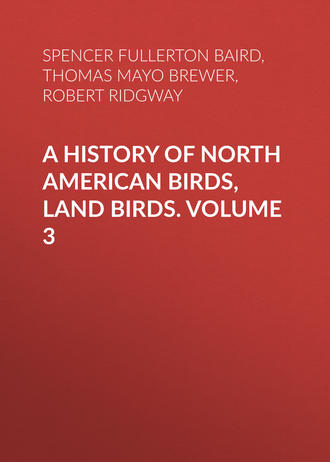 полная версия
полная версияПолная версия
A History of North American Birds, Land Birds. Volume 3
My determination of the number and character of the geographical races of F. gyrfalco is the result of a very careful critical examination of over sixty specimens, aided by the important conclusions of Mr. Hancock (Annals and Magazine of Natural History, 2d ser., XIII, 110; London, 1834), Schlegel (Falcones, Muséum d’Histoire Naturelle des Pays-Bas, 1862), Pelzeln (Uebersicht der Geier und Falken der Kaiserlichen ornithologischen Sammlung, April, 1863), and Alfred Newton (History of British Birds, revised ed., part 1, June, 1871, pp. 36–52, and Proc. Acad. Nat. Sc. Philadelphia, July, 1871, pp. 94, 95), in their important papers bearing upon this subject, which, though they each express the peculiar individual views of the writer, together clear up pretty satisfactorily the problem of the number, character, and habitats of the several races, as well as the different phases of variation to which each is subject.
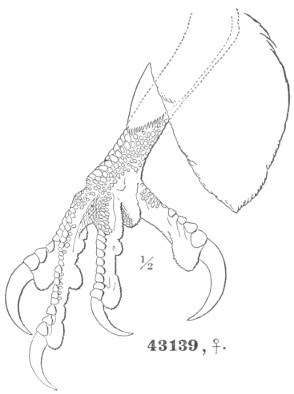
43139, ♀. ½
Falco sacer.

43139, ♀. ¼
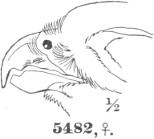
5482, ♀. ½
Falco polyagrus.
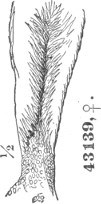
43139, ♀. ½

5482, ♀. ½
In studying the F. lanarius, I have experienced most discouraging difficulties from the want of sufficient series of the Old World races, and from the unsatisfactory character of most descriptions and figures of them, besides being much perplexed by the confusion of their synonymy by different authors. In consequence of this, my diagnoses of the four races of which alone I have seen examples may be very unsatisfactory as regards the characters by which they may be most readily distinguished. Having seen the adult of only a single one of these four races, I am therefore compelled to base my differential characters upon the immature stages.
In addition to the four races of F. lanarius characterized above, there are several geographical forms belonging to the Old World, chiefly intertropical Asia and Africa. These are the var. babylonicus, Scl. and Irby, (Gray’s Hand List, I, p. 20, No. 173,) of Southeastern Europe and Western Asia; var. barbarus, L. (Gray’s Hand List, p. 20, No. 174), of Northern Africa; and var. tanypterus, Licht. (Gray’s Hand List, No. 175), of both the preceding regions, which Mr. Gurney writes me “is simply the intertropical race of F. lanarius, from which it only differs in being of a darker shade throughout.” The F. saker, Schleg. (Gray’s Hand List, No. 176), seems, to judge from the descriptions and figures which I have seen, to be also merely a form of the same species, but I have seen no specimens of it.
Falco (Hierofalco) gyrfalco, LinnVar. candicans, GmelinWHITE GERFALCONAccipiter falco freti hudsonis, Bris. Orn. I, 356, 1763. A. gyrfalco, Briss. Orn. I, 370, pl. xxx, f. 2, 1763. Falco rusticolus, Fabr. Faun. Grœn. p. 55, 1780.—Lath. Syn. Supp. I, 15, 1781. F. candicans, Gmel. Syst. Nat. p. 275, 1788.—Daud. Tr. Orn. II, 101, 1800.—Benick, Isis, 1824, 882.—Schleg. Krit. Ubers. p. 1, 1844.—Bonap. Rev. Zool. 1850, 484; Consp. Av. p. 33.—Cassin, Proc. Ac. Nat. Sc. Phil. 1855, 278; Birds N. Am. 1858, 13.—Strickl. Orn. Syn. I, 77, 1855.—Blasius, Cab. Jour. 1862, 43 (thinks all boreal ones same in Europe and America).—Elliot, Birds N. Am. pl. xii. Hierofalco candicans, Cuv. Reg. An. ed. 1, I, 312, 1817; ed. 2, I, 323, 1829.—Less. Man. Orn. I, 80, 1828; Tr. Orn. p. 97, pl. xvi, p. 2.—Gray, Hand List I, 18, 1869. Falco islandicus, Lath. Ind. Orn. p. 32, 1790; Syn. I, 71, A, B; Gen. Hist. I, 72, A, 1821.—Steph. Zool. XIII, pt. ii, p. 39, 1826.—Gould, B. Eur. pl. xix.—Aud. Birds Am. 1831, pl. ccclxvi. F. buteo β, Lath. Ind. Orn. p. 24, 1790; Gen. Hist. I, 80, A. F. lagopus, β, Lath. Ind. Orn. p. 19, 1790; Syn. Supp. I, 36; Gen. Hist. I, 68, A. F. grœnlandicus, Daud. Tr. Orn. II, 157, 1800. Hierofalco grœnlandicus, Brehm. Voy. Deutsch, I, 16, 1831. F. gyrfalco, Bonap. List, p. 4, 1838.
Sp. Char. Adult (♀, 18,577, Greenland; Univ. Zool. Mus. Copenhagen). Ground-color entirely pure white; whole upper surface (posterior to the nape) with transverse crescentic bars of dark plumbeous-brown, generally about two on each feather, the first concealed by the feather which overlaps. Primaries crossed at regular intervals with quadrate spots of the same tint, these becoming fused toward ends of quills, forming a terminal dusky space of two or three inches in extent; tips of all the quills narrowly white; the black bars do not extend quite to the primary coverts, and decrease both in extent and regularity toward the base. Middle tail-feathers crossed with seven or eight imperfect bars of dusky, the shafts of the feathers blackish; rest of tail immaculate, the shafts pure white. Nape with a very few fine shaft-streaks of dusky. Whole lower surface of body and wing utterly immaculate. Wing-formula, 2–3–1. Wing, 16.50; tail, 9.00; culmen, 1.05; tarsus, 2.10–1.35; middle toe, 2.20; inner, 1.50; outer, 1.50; posterior, 1.00.
(No. 56,152, ♀, Greenland; Schlüter Collection.) Head above, occiput, nape, and upper half of ear-coverts, with sparse shaft-streaks of black, these most numerous on the latter region; primaries barred to the coverts. Tail entirely crossed by eleven plumbeous bars. Bars above clearer plumbeous. The snowy-white beneath is relieved by a few minute variable flecks of dusky upon the lower part of the abdomen, becoming larger as they approach the sides. Wing-formula, 2–3–1. Wing, 16.70; tail, 9.30.
Juv. transition stage? (♂ 56,047, “Hoher Norden”; Schlüter Collection). Markings above quite different from those of the two preceding; each feather has a large central longitudinal sagittate spot of dusky, leaving only the borders (of the exposed portion) white; on the primaries the dusky is almost confined to the terminal portion; the rump and upper tail-coverts have each feathers with a medial longitudinal stripe of dusky. The tail is immaculate, but the shafts of the middle feathers are dusky. The neck, breast, abdomen, and sides have numerous cuneate marks of dusky, one near the end of each feather. The lining of the wing, even, has a few narrow streaks. Wing, 14.75; tail, 9.40.
No. 56,049 (♀, Greenland, Schl. Coll.) is similar in pattern of markings, but above the dusky is more extended, forming the predominating color; the rump, etc., has broad sagittate spots instead of narrow stripes; the primaries are barred to the coverts; the tail is crossed by about ten continuous bands of dusky. Beneath the lanceolate spots or streaks cover the whole surface, except the anal region, lower tail-coverts, and throat. On the lining of the wing the streaks are less sparse than in the preceding, though they are by no means numerous. Wing, 15.75; tail, 9.50.
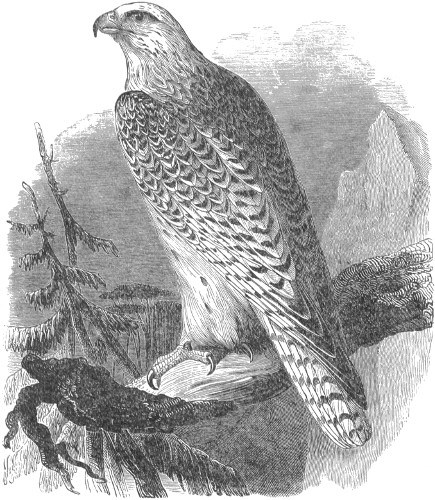
Falco candicans.
Juv. first plumage (♀, 56,053, Greenland; Schlüter Coll.). All the markings are longitudinal, instead of directly the reverse. The upper parts have longitudinal tear-shaped stripes, a medial one on each feather; they are sparse, however, on the wings; the rump has narrow shaft-lines of dusky. The tail and upper coverts are immaculate, but the shafts of all the feathers are nearly pure black. The bars on the primaries are found only immediately next the dusky terminal space. The streaks beneath are not very numerous, and are found only on the breast, upper part of abdomen, and on the sides; the nape and sides of the neck are, however, thickly streaked.
(No. 17,966, ♀, Moose Factory, Hudson Bay Territory.) In character of markings resembling the last, but the stripes are fainter and narrower; they are also less numerous. On the under parts they are wanting. Unfortunately, the tail of this specimen, which is the only North American one in the collection, is missing.
In all specimens the anal region and lower tail-coverts are immaculate.
Hab. Greenland, and continent of North America, north of Hudson Bay (breeding in latter region). Of irregular occurrence in winter throughout the circumpolar regions; Ural Mountains (Eversman); Behring’s Strait (Bannister).
LIST OF SPECIMENS EXAMINEDNational Museum, 7; Boston Society, 2; Philadelphia Academy, 3; New York Museum, 6; collection of R. Ridgway, 1. Total, 19.

Accipiter falco islandicus, Briss. Orn. I, 336, 1763. Falco islandicus, Sab. Linn. Trans. XII, 528, 1818.—Temm. Man. Orn. pt. x; 17, pt. iii, p. 9; Tab. Meth. p. 2, 1836.—Faber, Prod. Island. Orn. 1822, p. 2; Isis, 1827, 62.—Rich. & Swains. F. B. A. II, 27, 1831.—Hoy, Mag. Nat. Hist. Ser. 1, VI, 107.—Hancock, Ann. Nat. Hist. II, 247; Rev. Zoöl. 1839, 123.—Bonap. Consp. Av. p. 24.—Strickl. Orn. Syn. I, 77, 1855.—Cassin, Birds N. Am. 1858, 13. Hierofalco islandicus, Gray, Gen. B. p. 3 (ed. 2, p. 4), 1844; Hand List, I, 18, 1869. Falco candicans islandicus, Schleg. Krit. übers, p. 1, 1844. Falco lanarius, Faber, Isis, 1827, 68. Falco gyrfalco, Keyserling & Blasius, Wirbelth. Eur. p. 135, 1840.
Sp. Char. Adult (♂, Iceland; No. 12, Coll. Geo. N. Lawrence). Ground-color of the plumage dull white, gradually becoming somewhat bluish posteriorly, this color especially noticeable on the tail. Whole upper parts crossed with broad transverse bands of dark plumbeous, these bands continuous, and more than twice as wide as the pale ones, except on the upper tail-coverts and tail, where the bands of the two colors are more regularly defined and about equal; in addition to the transverse bands, the feathers anteriorly have narrow borders of white. Tail with the dark bands twelve in number; the terminal pale band is purer white than the others. The dusky plumbeous prevails on the primaries, and is unvariegated beyond the middle portion; the anterior half, however, is marked with quadrate ragged spots, of a slightly yellowish-white; all are margined terminally with purer white. Each feather of the head and neck with a narrow medial streak of dusky, but the general aspect abruptly lighter than the back; the streaks are more condensed along the upper and terminal portion of the ear-coverts. Jugulum and breast with a medial narrow streak on each feather; abdomen with more elliptical streaks; sides with circular and cordate spots, and flanks and tibiæ with transverse spots; lower tail-coverts with narrow shaft-streaks of dusky. Lining of the wing with sparse narrow streaks of dusky; under surface of primaries with white prevailing, this, however, crossed by narrow bars of dusky, these numbering about sixteen on the longest. Wing-formula, 2–3–1. Wing, 14.60; tail, 7.80; culmen, 1.00; tarsus, 2.30; middle toe, 2.00.
Juv. (No. 20,344, Iceland). Ground-color of head, neck, and lower parts, white. Upper surface grayish umber-brown, becoming paler and more grayish on the tail; each feather above sharply bordered (both webs, all round) with dull white, producing a somewhat squamate appearance; in places, a few obsolete hidden spots of yellowish-white. Tail ashy-drab (feathers somewhat paler along edges), crossed with about eleven transverse series of spots of ochraceous or creamy white; these very obsolete on middle feathers, and sharply defined only on inner webs; the last is terminal. Primaries plain brown, somewhat darker than the back, and becoming insensibly darker terminally; skirted with white, and somewhat mottled or irregularly spotted toward their bases with yellowish-white. Head and neck, each feather, with a medial streak of dusky, but white the prevailing aspect; these streaks condensed and somewhat suffused along upper border of ear-coverts, and from the lores along cheeks, forming an obsolete “mustache”; every feather beneath (including lining of wings) with a medial broad stripe of clear plumbeous vandyke-brown, the shaft pure black; under surface of primaries with transverse spaces of white, these numbering thirteen on the longest. Wing-formula, 2–3, 1. Wing, 15.00; tail, 9.20.
Hab. Iceland and Southern Greenland. Northeastern North America in winter, straggling accidentally south to the New England States; Rhode Island (Museum, Cambridge); Norway, Maine “not uncommon” (Verrill); Massachusetts (Peabody & Jillson); Long Island (Cab., G. N. Lawrence).
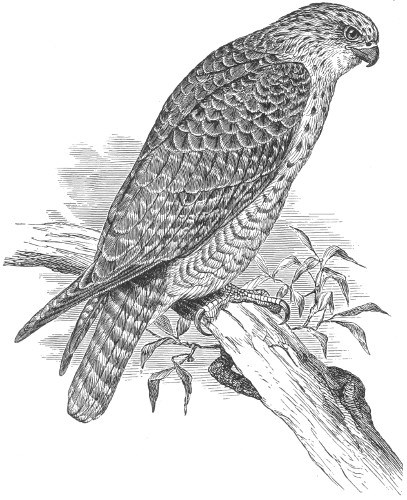
Falco islandicus.
No. 56,050, Greenland (Schlüter Collection), is moulting, and assuming the adult dress; the adult and young stages above described being nearly equally combined. No. 56,055, from Greenland, differs from the other young individuals which I have seen in being considerably darker. The feathers of the upper surface are not bordered with whitish, but are merely paler on their edges, along which are specks of yellowish. On the head and neck the dark streaks predominate, while the stripes below are very broad. It approaches quite nearly toward the young of var. sacer.
The only specimen of this race which I have seen from Continental North America, is a young individual, obtained during the winter of 1864–65, near Providence, R. I., taken by Mr. Newton Dexter, and now in the Cambridge Museum, where I had the pleasure of seeing it.
LIST OF SPECIMENS EXAMINEDNational Museum, 5; Boston Society, 3; Philadelphia Academy, 9; Coll. G. N. Lawrence, 2; Museum Comp. Zoöl., 1; New York Museum, 5. Total, 25.

Falco sacer, Forster, Phil. Trans. LXII, 1772, 383 and 423.—Coues, Birds of New England, 1868, 6.—Baird, Trans. Chicago Acad. Sc. I, ii, 271. ? Falco cinereus, Gmel. Syst. Nat. p. 267, 1789.
Sp. Char. Adult (♂, 51,689, Yukon, mouth of Porcupine River; Strachan Jones). Whole upper surface with numerous transverse bands of brownish-plumbeous and ashy-white. Anteriorly the light bars are about half the width of the dark ones; posteriorly they gradually increase, the bands of the two colors being about of equal width on the upper tail-coverts and tail; with the increase of the lighter bars, they become more ashy, and, correspondingly, the darker ones are more plumbeous; on the rump there is but little contrast between the bands of the two, causing a prevalent bluish cast. The bands are everywhere continuous, the light ones being interrupted only by the black shaft; there are generally on the anterior portions about three light bars on each feather, the last always terminal. Tail tipped with white, and crossed with equal continuous bands of hoary-plumbeous and ashy-white; the latter eleven in number, and finely sprinkled with deeper ash. Primaries brownish-plumbeous, plain past the middle portion, but on the anterior half with quadrate spots of creamy white on the outer web. Head above brownish-plumbeous, this prevailing; but along the median line the feathers are edged with buffy white; forehead dull white, this continuing back in a streaked superciliary stripe to the occiput; cheeks very thinly marked with fine streaks of dusky, this prevailing along the upper border of the ear-coverts; a deeper dusky suffusion beneath the anterior angle of the eye. Lower surface pure white; chin and throat, only, immaculate; jugulum with very sparse, narrow longitudinal streaks of blackish; sides with scattered cordate or nearly circular spots, these larger and transverse on the flanks and tibiæ; abdomen with scattered minute elliptical spots; lower tail-coverts with minute irregular sagittate or transverse spots of dusky. Under surface of the wing white; each feather of the lining with a medial tear-shaped streak of dusky; primaries crossed with narrow bars of dusky, fifteen in number on the longest. Wing-formula, 2–3–4–1–5. Wing, 13.50; tail, 8.60; culmen, .90; tarsus, 2.15; middle toe, 1.87.
♀ (43,139, Fort Anderson, May 24, 1864, “♀ and two eggs”; R. MacFarlane). Generally similar to the male. Head above conspicuously streaked, but the dusky prevailing. Above the transverse bands are less regular and continuous, anteriorly the plumbeous largely prevailing; posterior portions, however, as in the male, but on the rump the bands are more distinct. Beneath, the markings are more numerous, larger, and broader; those on the jugulum linear; those of the abdomen medially elliptical; laterally they are transversely cordate, and on the flanks in form of broad transverse spots, or broad bars; on the tibiæ and lower tail-coverts they form regular transverse bars,—on the latter, quite distant. Wing-formula, 2–3–4, 1. Wing, 15.50; tail, 9.50; tarsus, 2.15 and .80; middle toe, 1.95.
Juv. (♂, 55,400, Alaska, Nulato, February 10, 1868; W. H. Dall). Above plumbeous-umber, precisely as in young of islandicus, but on the rump having a decided ashy cast. No white edges to the feathers, as in islandicus, but, instead, numerous irregular transverse spots or obsolete ragged bars of cream-color or pale ochraceous-buff; the whole upper surface is quite thickly variegated with these irregular markings. Tail crossed with thirteen narrow bands of creamy-white, these so thickly mottled with dusky on the outer webs as to be obscure, but on inner webs they are regular and sharply defined; the last is terminal. Primaries plain dusky, skirted obscurely with paler, and marked toward bases with obsolete mottled spots of cream-color. Head streaked with dusky and creamy-white, the former predominating on upper surface, along upper edge of ear-coverts, and across the cheeks, on the latter forming a mustache; the white prevails over the ear-coverts in a broad supra-oral stripe, and on the forehead and lores. Beneath, soft dull white; chin and upper part of throat, only, immaculate; each feather with a broad medial stripe of clear dark plumbeous-brown, on the flanks and tibiæ prevailing, the whitish assuming the form of roundish spots; lining of the wing similarly marked; prevailing aspect of under surface of primaries white, crossed with narrow bars of ashy, fifteen in number on the longest. Wing-formula, 2, 3–1=4. Wing, 14.00; tail, 8.40.
Hab. Interior regions of Arctic America; Anderson River, McKenzie, Yukon, and Severn River regions. Breeding abundantly in the former district, whence numerous specimens of skins and eggs have been received by the Smithsonian Institution.
In the young specimen described, there are one or two new feathers appearing on the rump and upper tail-coverts, precisely as in the blue plumage, and proving conclusively their relationship. The species is as different from the Iceland bird in the young stage as in the mature. The most readily apparent differences are, lack of sharp white edges of feathers above, and in their stead numerous ragged transverse spots of yellowish; dark aspect of head above, etc.
Specimens vary considerably in the shades of color and distribution of the markings, but the types of the above descriptions are the lightest of the series. The darkest example is No. 43,144½ (“♀ and eggs”), Fort Anderson, May 22, 1864. In this the whole head and neck (except underneath) are continuous blackish-plumbeous, only the middle of the auriculars being faintly streaked; the back is nearly plain dusky, and even on the wings the bars are very obscure and much reduced in width. The rump is plain ashy-blue, the darker bars being nearly obsolete. The longitudinal markings on the pectoral region are enlarged into conspicuous stripes, while on the sides and flanks the transverse bars form heavy spots. The transverse bars on the tibiæ are ashy-blue; those on the crissum clear plumbeous, and regularly transverse. Wing, 15.75; tail, 9.30. Upon comparing this specimen with the figures of a pair of var. gyrfalco, by Wolf, in Newton’s Oötheca Wolleyana, I can discover no difference at all; thus it would seem that our bird occasionally closely approaches in tints and markings this race of Continental Europe, of which I have seen only one immature example, and no adults.
I cannot agree with Mr. Newton in considering the Gerfalcons of the interior of Arctic America as identical with the Iceland form, though that distinguished ornithologist considers them so in his paper in the Proceedings of the Philadelphia Academy for July, 1871, basing his conclusion upon the specimens from which the above descriptions were taken, which had been sent over to England for comparison. I have never yet seen a specimen of islandicus which could not be distinguished, by the characters given in my synopsis, from these examples, while they can be separated from that race by the characters which Mr. Newton himself gives, in his diagnostic table in the paper above cited, for distinguishing the adults of islandicus and gyrfalco.
The var. sacer is evidently separable from both islandicus and gyrfalco, and about as much related to one as to the other; combining the size and proportions of the former with the colors of the latter, while in the wide amount of individual variation of plumage its lighter extreme approaches one, while its darkest phase approximates as closely to the average plumage of the other.
LIST OF SPECIMENS EXAMINEDNational Museum, 6.

Falco labradora, Aud. B. Am. pl. cxcvi, 1831.
Sp. Char. Adult (♀ breeding plumage? 30,375, Rigolet, Labrador; Mr. Conolly). Ground-color of the plumage uniform, very deep, clear, dark plumbeous-brown, continuously uniform above; larger scapulars, secondaries, secondary coverts, and primaries more dilute along edges, however, the tint palest and broadest terminally. Tail perfectly uniform, except at the end; the tip being narrowly whitish, and about half an inch anterior to this, a transverse series of hidden irregular transverse creamy-white spots. The head (except beneath) is unvariegated. Beneath, the dark tint inclines more to blackish clove-brown, more dilute on the tibiæ; feathers edged laterally with white, this prevailing on the throat, but everywhere else far less than the dusky in amount; on the tibiæ and lower tail-coverts the white is in the form of irregular spots. Anal region unvariegated; lining of the wing with circular spots of white along the outer webs of the feathers. Under surface of primaries with plumbeous prevalent, but this crossed with mottlings of whitish, forming transverse bars; but terminally and basally they become confused or lost. Wing-formula, 2, 3–1, 4. Wing, 16.20; tail, 9.50; tarsus, 2.00–.90; middle toe, 2.05; inner, 1.50; outer, 1.50; posterior, .90.
Hab. Labrador; south and westward in winter, and shores of Hudson Bay.
Nos. 17,063 (♀, Quebec, W. Cooper) and 34,960 (♀, Fort Nescopec, Labrador) differ from the preceding in having ten small narrow transverse spots of reddish-white on the tail-feathers, forming as many indistinct bands; these spots touch neither the shaft nor the edge of the feather, and are almost concealed, unless the tail is spread; on the latter specimen they are very obsolete, the subterminal one only being distinct, as in the specimen selected for description. The upper tail-coverts also show faintly indicated spots, and the former specimen has the wing-coverts with very narrow irregular spots on the edge of the feathers. In this specimen there is also one feather in the scapulars which has broader white edges; it also has the white below about equal to the black in amount; the anal region, however, in all, is unvaried blackish, and the transverse oblique bands on the lower tail-coverts are a constant feature.
No. 41,185 (♀, Fort Nescopec, Labrador; H. Conolly) is the darkest of all. In this the blackish plumbeous-brown is uniform over the whole surface; even the throat is unvariegated. Abdomen with a few of the feathers edged with white, and sides with a few small circular spots of the same; lower tail-coverts transversely spotted with white; tibiæ scarcely variegated, showing only narrow indistinct whitish edges. Mottling on inner webs of primaries reduced so as to be scarcely visible. Tail with the usual number (two) of irregular whitish bars,—one terminal, the other near the end.




